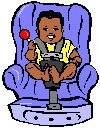Buckle Up the Children
(It is really the right thing to do)
 It is the driverís responsibility and legal obligation to
ensure that children are buckled up with restraints in a vehicle. A child
restraint appropriate to the childís age and weight should be worn. It is
essential to buy a correctly fitting child restraint and to use it properly.
There are three good reasons to wear a seat belt or to make use of a child
restraint or child seat: It is the driverís responsibility and legal obligation to
ensure that children are buckled up with restraints in a vehicle. A child
restraint appropriate to the childís age and weight should be worn. It is
essential to buy a correctly fitting child restraint and to use it properly.
There are three good reasons to wear a seat belt or to make use of a child
restraint or child seat:
-
It can save your life as the driver
-
It can save the lives of your passengers
-
The law requires you to wear seat belts in the front and
rear seats
As a parent and driver, it is your responsibility to ensure
the safety of your children when travelling. The following tips and hints should
be followed:
-
 Never place a rear-facing car seat in a passenger seat that
has an airbag. If you are not sure whether your car has airbags, check with
your dealer. Airbags deploy with considerable force and can harm children who
are not properly buckled up or those in rear facing restraints Never place a rear-facing car seat in a passenger seat that
has an airbag. If you are not sure whether your car has airbags, check with
your dealer. Airbags deploy with considerable force and can harm children who
are not properly buckled up or those in rear facing restraints
-
Ensure that child seats are installed correctly. If you
need help or information on how to install them, call your automobile
association or contact the store where you bought them
-
Adjust the harness of the child seat each and every time
you put your child into it. You need to take into account what the child is
wearing. There should be only enough room to slip two fingers between the
webbing and your child
-
Teach your child not to try to free herself from the seat.
No seat, no matter how well made, is absolutely child-proof
-
Cover the child seat if your car is going to be left in the
sun for any amount of time. Its metal fittings can get extremely hot and burn
your child
-
Check the seat regularly. If you detect signs of fraying on
the webbing, you need to replace the seat immediately
-
Replace the child seat if you have been in an accident. The
seat may appear to be undamaged but it may have been subjected to internal
wear and tear in the collision
-
Unless you know the history of a second-hand car seat, do
not buy it. The authorities recommend that you avoid buying second-hand seats.
Even if the seat looks all right, there may be internal wear. Second-hand
seats may also be of an older design and may not have advanced safety features
-
Buy the correct car seat for your childís weight Ė not
for his/her age
-
Buy only SABS tested and approved child seats
- When your childís weight reaches the limit of the seatís capacity,
replace it with one suitable for the childís present weight

 back back
|